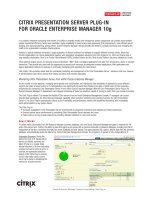Oracle Enterprise Manager Grid Control 11gR1: Business Service Management pdf
Bạn đang xem bản rút gọn của tài liệu. Xem và tải ngay bản đầy đủ của tài liệu tại đây (12.67 MB, 360 trang )
Oracle Enterprise Manager
Grid Control 11gR1: Business
Service Management
A hands-on guide to modeling and managing business
services using Oracle Enterprise Manager 11gR1
Ashwin Kumar Karkala
Govinda Raj Sambamurthy
P U B L I S H I N G
professional expertise distilled
BIRMINGHAM - MUMBAI
Oracle Enterprise Manager Grid Control 11gR1:
Business Service Management
Copyright © 2011 Packt Publishing
All rights reserved. No part of this book may be reproduced, stored in a retrieval
system, or transmitted in any form or by any means, without the prior written
permission of the publisher, except in the case of brief quotations embedded in
critical articles or reviews.
Every effort has been made in the preparation of this book to ensure the accuracy
of the information presented. However, the information contained in this book is
sold without warranty, either express or implied. Neither the authors, nor Packt
Publishing, and its dealers and distributors will be held liable for any damages
caused or alleged to be caused directly or indirectly by this book.
Packt Publishing has endeavored to provide trademark information about all of the
companies and products mentioned in this book by the appropriate use of capitals.
However, Packt Publishing cannot guarantee the accuracy of this information.
First published: May 2011
Production Reference: 1130511
Published by Packt Publishing Ltd.
32 Lincoln Road
Olton
Birmingham, B27 6PA, UK.
ISBN 978-1-849682-16-9
www.packtpub.com
Cover Image by David Guettirrez ()
Credits
Authors
Ashwin Kumar Karkala
Govinda Raj Sambamurthy
Reviewers
Eric Bowman
Hari Charan R Rao
William Vambenepe
Acquisition Editor
Kerry George
Development Editor
Susmita Panda
Technical Editors
Merwine Machado
Azharuddin Sheikh
Project Coordinator
Zainab Bagasrawala
Proofreader
Lynda Sliwoski
Indexer
Monica Ajmera Mehta
Graphics
Nilesh Mohite
Geetanjali Sawant
Production Coordinator
Shantanu Zagade
Cover Work
Shantanu Zagade
About the Authors
Ashwin Kumar Karkala, a software development manager, is based out of
Bangalore and is part of the Enterprise Manager Product group at Oracle. He has
around 12 years of experience in the IT industry and has developed a wide range
of enterprise grade solutions for various industries. At Oracle, he has worked
on multiple versions of the Enterprise Manager Grid Control product and is
responsible for developing solutions in many areas, some of which include Business
Services Management, middleware diagnostics, cloud management, and identity
management. His other areas of interest include Service Oriented Architecture and
Web 2.0 technologies.
I extend my sincere thanks to my parents, my wife Sandhya, and my kids
Anup and Stuthi, for their patience and support over many a weekend that I
spent writing this book.
I also thank my management chain at Oracle—Richard Sarwal, Ali Siddiqui,
Rajiv Maheshwari, and Rahul Goyal for extending their fullest support
towards this book.
I would also like to thank my colleagues and friends—Sundar Ramaswami,
Priya Ulaganathan, Rajesh Polavarapu, and Arvind Maheshwari who helped
and supported us at various stages while writing this book.
I also thank the team at Packt Publishing including Kerry George, Zainab
Bagasrawala, Susmita Panda, Merwine Machado, and Azharuddin Shaikh who
patiently worked with us and helped the book see the light of day.
Many thanks to the technical reviewers—William Vambenepe, Hari Rao, and
Eric Bowman for taking the time to read the drafts and providing us with
valuable inputs that helped elevate the standard of the content.
Last but not least, this book would not have become a reality without
the passion, dedication and hard work of my co-author Govinda Raj
Sambamurthy. I thank him whole heartedly for making this journey
worthwhile.
Govinda Raj Sambamurthy, is a principal member technical staff in the content
management space in the Oracle Fusion Middleware team at Bangalore, and is
responsible for building highly available and highly scalable enterprise middleware
products. He has around nine years of experience in the IT industry and has played
the role of developer, consultant, and technical lead in developing software for
banking and nancial, retail, and telecom verticals as well as product development,
building enterprise solutions that are deployed in high-availability architectures.
He was part of the Service-Level Management pack development team in Oracle
Enterprise Manager Grid Control 10g and 11gR1. His areas of interest include
business services management, middleware diagnostics, service-level management,
cloud computing, enterprise 2.0, and semantic Web.
I thank my mother Padma who has been an inspiration all through my life, for
her immense support and continuous encouragement. I would like to extend
thanks to my wife Nithya, for her patience and support in letting me use
precious family time over weekends to work on this book.
I also thank my management chain at Oracle—Hari Rao, Frank Radichel, and
Hasan Rizvi for allowing me to t this book into my schedule, and for their
constant encouragement.
I also thank my colleagues Rahul Goyal, Arvind Maheshwari, Chandrasekhar
Atla, Rama Vijjapurapu, Sreekanth Chintala, and Venkatesh Yadalam for their
help at various stages of this book.
I also thank the team at Packt Publishing including Kerry George, Zainab
Bagasrawala, Susmita Panda, Merwine Machado, Azharuddin Shaikh and
others from the publishing team for all their support.
A special thanks to our technical reviewers—Hari Rao, William Vambenepe,
and Eric Bowman who took time off their busy schedules to read the drafts
and provided us with technical inputs.
Last but not least, the commitment, resolve and efforts of my co-author
Ashwin Kumar Karkala were essential in planning and executing this with
the nesse of a project delivery. I thank him whole heartedly for ensuring
this a success.
About the Reviewers
Eric Bowman is a software architect based in Ireland, who is an expert in
distributed systems and service delivery. He has delivered products across a variety
of industries from computer games to mobile telecommunications to location-based
services. He is a Java expert, Scala lover, lucky husband, and proud father.
Hari Charan R Rao is Director, Product Development at Oracle India. Hari brings
over 17 years of software product development experience including seven years of
product development and large enterprise software deployment experience.
Hari has technical expertise in Database Server Extensibility, Distributed Systems,
and Collaboration Systems with emphasis on scalability, reliability, and high
availability. For the last several years he was involved in the design, development
and deployment of Real Time Collaboration systems within large enterprises. In
addition, he has had several opportunities to work with demanding customers both
inside and outside his company.
I would like to thank the authors and Packt Publishing for giving me an
opportunity to take part in reviewing the book. I would also like to thank my
family, who let me have the time towards the review.
William Vambenepe is a software architect at Oracle. His focus is on Cloud
Computing, application management, and middleware management.
www.PacktPub.com
Support files, eBooks, discount offers, and more
You might want to visit www.PacktPub.com for support les and downloads related to
your book.
Did you know that Packt offers eBook versions of every book published, with PDF and ePub
les available? You can upgrade to the eBook version at www.PacktPub.com and, as a print
book customer, you are entitled to a discount on the eBook copy. Get in touch with us at
for more details.
At www.PacktPub.com, you can also read a collection of free technical articles, sign up for a
range of free newsletters, and receive exclusive discounts and offers on Packt books and eBooks.
Do you need instant solutions to your IT questions? PacktLib is Packt's online digital book
library. Here, you can access, read, and search across Packt's entire library of books.
Why subscribe?
Fully searchable across every book published by Packt
Copy and paste, print, and bookmark content
On demand and accessible via web browser
Free access for Packt account holders
If you have an account with Packt at www.PacktPub.com, you can use this to access PacktLib
today and view nine entirely free books. Simply use your login credentials for immediate access.
Instant updates on new Packt books
Get notied! Find out when new books are published by following @PacktEnterprise on
Twitter, or the Packt Enterprise Facebook page.
•
•
•
Table of Contents
Preface 1
Chapter 1: Business Service Management: An Overview 7
Complexity in data centers 8
Modeling 10
DBA perspective: An example 12
Composite view: An example 13
Business view: An example 14
Target modeling 15
Systems and groups modeling 18
Services modeling 22
System-based service model 26
Synthetic transaction-based service model 28
Information Technology Infrastructure Library guidelines 30
Summary 32
Chapter 2: Modeling IT Infrastructure Using Oracle
Enterprise Manager 11gR1 33
Oracle Enterprise Manager concepts 34
Flavors of Oracle Enterprise Manager 36
OEM Database Control 38
OEM application server and Fusion Middleware Control 39
OEM Grid Control (GC) 40
OEM Grid Control 11gR1 architecture 43
Oracle management agent 45
Local monitoring 46
Remote monitoring 46
Oracle Management Service (OMS) and console 47
Table of Contents
[ ii ]
Target modeling 47
Target discovery 50
Agent-monitored and repository targets 50
Availability management 52
Performance management 54
Alerts 55
Target home page 56
Passive and active monitoring 57
Composite targets 58
Group targets 60
System targets 61
Service targets 62
Service-level management 65
Product and management focus areas in OEM 11gR1 66
Summary 67
Chapter 3: Modeling Groups and Systems 69
Groups modeling with OEM Grid Control 69
Types of groups in OEM Grid Control 71
Integrator defined group types 71
Group types and availability management 72
Creating groups in OEM Grid Control 72
Normal group 73
Privilege propagating group 78
Redundancy group 80
Monitoring and managing group targets 83
Group home page 83
Redundancy group home page 86
Group monitoring 87
Group management 89
Systems modeling with OEM Grid Control 91
Types of system targets in OEM Grid Control 93
System targets and availability management 93
Creating system targets in OEM Grid Control 94
Creating a system target flow 94
Monitoring and managing system targets 101
System home page 102
System charts 103
System administration 104
System components 104
System topology 104
Summary 107
Table of Contents
[ iii ]
Chapter 4: Modeling Services 109
Service modeling with OEM Grid Control 109
Introduction to services 110
Business services as targets in OEM Grid Control 110
Passive and active monitoring 111
Business service availability management 114
Introduction to service availability 114
Availability based on system 115
Availability based on service test 117
Service targets supported in OEM Grid Control 120
Web application 121
Forms application 122
Generic service 123
Aggregate service 123
Out of box custom services 124
Creating services based on a system target 124
Creating generic services based on a system 124
Create generic service: General step 126
Create generic service: Availability step 129
Create generic service: Performance metrics step 130
Create generic service: Usage metrics step 131
Create generic service: Review step 132
Creating services Using command-line scripts 132
Monitoring services 134
All services page 134
Status column 135
Performance alerts 135
Usage alerts 136
System details 137
Key tests 137
Monitoring beacons 138
Generic service home page 138
General section 139
Key component summary region 141
All service alerts region 142
Performance and usage region 143
Key test summary region 143
Service charts tab 144
System tab 145
Topology tab 146
Service blackouts 147
Creating a service blackout 148
Availability status history 152
Table of Contents
[ iv ]
Editing services 154
System configuration 157
Availability definition 159
Root cause analysis 160
Configuration 161
Service failure: Diagnostics using root cause analysis 165
Automatic root cause analysis 165
Manual root cause analysis 168
Summary 168
Chapter 5: Service Modeling Using Synthetic Transactions 169
Active monitoring with OEM Grid Control 170
Introduction to active monitoring 170
Beacons 171
Service tests 174
Licensing information 178
Creating services based on service tests 179
Creating Generic Service based on host ping test 179
Creating Generic Service: General step 180
Creating Generic Service: Availability step 182
Creating Generic Service: Service test step 182
Creating Generic Service: Beacons step 184
Creating Generic Service: Performance metrics step 188
Creating Generic Service: Usage metrics step 189
Creating Generic Service: Review step 190
Creating services based on command-line scripts 190
emcli create_service verb 191
Prominent service test types 192
Host ping service test type 194
FTP service test type 195
HTTP ping service test type 197
LDAP service test type 199
Web service (SOAP/REST) service test type 200
Other test types 202
Custom script test type 203
Advanced service test type: Web transaction 204
Web transaction recording 204
Steps and step groups 206
Web transaction playback options 207
Debugging issues related to web transactions 208
Monitoring services based on service tests 208
All Service page 209
Generic Service home page 209
Table of Contents
[ v ]
Key test summary section 209
Test Performance tab 210
Monitoring all service tests and all beacons 211
Monitoring a single service test: Test home page 216
Configuring metric thresholds and collection frequency for
service test metrics 217
Past changes and pending changes 220
Monitoring beacon Targets 222
Beacon home page 222
Beacon monitored targets 223
Watch Lists 223
Host ping using network watch list 224
HTTP ping using URL watch list 227
Ad hoc execution using the Test option 228
Summary 229
Chapter 6: Modeling Service Metrics 231
Metric collection using OEM Grid Control 231
Metrics 232
Collection interval 232
Metric thresholds and alerts 232
Service target metrics 233
Availability 233
Performance metrics 233
Usage metrics 234
Business metrics 234
Metric promotion for service targets 235
Metric promotion based on system components 237
Metric promotion based on service tests 237
Service metric creation using OEM Grid Control console 237
Performance metrics 238
Usage metrics 241
Service metric creation using command line 243
emcli set_metric_promotion verb 243
Editing service target metrics 246
Configuring metric collections and advanced settings 246
Monitoring service metrics 249
Monitoring metrics in the service home page 249
Monitoring metrics in the charts page 250
Monitoring service metric alerts 252
Service metric alerts in service target home page 252
Service metric alert details 253
Table of Contents
[ vi ]
Diagnosing metric promotion issues 254
Manual diagnostics 254
Diagnostics using promoted metrics diagnostics doctor 255
Summary 256
Chapter 7: Service-Level Management 257
Service-level agreements 257
Service-level management 258
Service-level management in OEM Grid Control 259
Service-level rule 259
Metrics used for service-level computation 260
Actual Service-level (%) computation 261
Defining service-levels in OEM Grid Control 261
Expected service-level 262
Actual service-level 262
Business hours 263
Availability criteria 263
Performance criteria 263
Monitoring service-levels using OEM Grid Control 264
Monitoring service-levels in service home page 264
Service-level Details page 265
Summary 267
Chapter 8: Modeling Composite Business Services 269
Introduction to composite business services 270
Aggregate service targets in OEM Grid Control 270
Modeling availability 272
Modeling key performance indicators 272
Modeling service levels 273
Creating aggregate service targets 273
Using OEM Grid Control console 274
Add aggregate service: Subservices tab 274
Add aggregate service: Performance tab 276
Add aggregate service: Usage tab 278
Using command-line scripts 279
emcli create_aggregate_service verb 279
Editing aggregate service targets 280
Monitoring aggregate service targets 281
Aggregate service home page 282
General section 283
Subservices region 283
Performance and usage region 284
Alerts region 284
Table of Contents
[ vii ]
Aggregate service charts tab 284
Topology tab 284
Diagnostics using Root Cause Analysis 285
Root Cause Analysis details 286
Root Cause Analysis configuration 287
Summary 288
Chapter 9: Real-Time Business Service Monitoring 289
Real-time monitoring in OEM Grid Control 290
Reports in OEM Grid Control 291
Reports customization 292
Report Definition: General tab 293
Report Definition: Elements tab 294
Report Definition: Schedule tab 295
Report Definition: Access tab 296
Dashboards in OEM Grid Control 296
Desktop widgets 297
Group and system monitoring dashboards 297
System dashboard drill downs 299
System monitoring dashboard customizations 299
Services monitoring dashboards 301
Services monitoring dashboard drill downs 302
Service Status dashboard 302
Service Detail dashboard 303
Service Level Details dashboard 304
Custom services monitoring dashboards 304
General options 306
Services options 306
Columns and time ranges options 306
Service Level and Monitoring widget 307
Prerequisites and installation of SLM desktop widget 308
Client-side prerequisites 308
OMS-side prerequisites 308
SLM widget setup 308
Configuring the SLM widget 308
Summary view 310
Detailed view 311
Sorting in the detailed view 312
Summary 312
Table of Contents
[ viii ]
Chapter 10: Business Service Management at your Data Center 313
Modeling IT infrastructure 314
Best practices for using group targets 314
Best practices for using system targets 315
Modeling business services 316
Best practices in the service target type selection 316
Best practices for system-based services 317
Best practices for test-based services 318
Best practices for modeling locations using beacons 319
Best practices for hybrid models 320
Best practices for modeling composite services 320
Modeling service hierarchy 321
Best practices for modeling service hierarchy 321
Monitoring business services 322
Management by Exception 322
Configuring metrics and thresholds 322
Configuring blackouts 323
Configuring service levels 324
Configuring monitoring templates 324
Configuring Root Cause Analysis 324
Configuring services monitoring dashboards 325
Lifecycle management 325
Provisioning 325
Configuration management 326
Patching and upgrades 327
Final words 327
Index 329
Preface
Oracle Enterprise Manager Grid Control is a release of Oracle Enterprise Manager
that's used to model and manage the entire Oracle Grid and beyond. It has
capabilities to manage a number of databases and application servers, and can
manage multiple instances of Oracle deployment platforms. Business Service
Management (BSM) is a methodology for monitoring and measuring Information
Technology (IT) services from a business perspective. The Business Service
Management capabilities of Oracle Enterprise Manager are available only
in the Grid Control avor.
What this book covers
Chapter 1, Business Service Management: An Overview, you will get a brief introduction
of the business service management space. This will include a brief overview of
today's data centers, followed by industry standard guidelines for managing the
complexities. It will also touch upon the Information Technology Infrastructure
Library (ITIL v3) guidelines on business service management.
Chapter 2, Modeling IT Infrastructure Using Oracle Enterprise Manager 11gR1, will
introduce Oracle Enterprise Manager related concepts such as Targets, Metrics,
Alerts, Beacons, Service Tests, and so on. This will be followed by an introduction
to System and Service target types. It will also cover the denitions of various
features such as Availability management, Performance management, and
Service-Level Management.
Chapter 3, Modeling Groups and Systems, will present the OEM Grid Control
capabilities in IT infrastructure management. Modeling IT infrastructure is a key
precursor to passive management of data center services. OEM Grid Control offers
capabilities to model IT infrastructure as systems, groups, and redundancy groups.
We will cover all the three areas with a thrust on systems modeling, that is,
in-depth coverage of the denition and conguration steps involved in
setting up and monitoring a system target in OEM Grid Control.
Preface
[ 2 ]
Chapter 4, Modeling Services, will expand on the concept of service targets and the
various options available to model them like generic service target, web application
target, forms application, and so on. In particular, this chapter will introduce the
steps involved in creation of a generic service target based on passive monitoring
using system target through both the GUI and command line. It will also give a
detailed overview of the various monitoring capabilities of service targets.
Chapter 5, Service Modeling Using Synthetic Transactions, will dive deeper into the
area of active monitoring using beacons and service tests. The topics covered include
extensive capabilities of the beacon target. It will also detail out the creation and
monitoring steps of various service test types such as Host Ping, FTP, Web Service,
and so on. The other areas covered include advanced synthetic transactions such as
web transactions using the out-of-box recorder and playback. The service availability
dependency on key tests and key beacons will also be covered.
Chapter 6, Modeling Service Metrics, will dive deep into the KPI modeling aspects of
service targets in OEM. The KPIs are modeled as Service Metrics and are promoted
from the underlying system and tests, as performance and/or usage metrics. This
process of metric promotion will be covered at length. In addition, this chapter will
also focus on setting thresholds on the service metrics so as to generate warnings and
critical alerts.
Chapter 7, Service-Level Management, you will be provided with a walk through on the
service-level management features in OEM Grid Control. This will include dening
service-level rules and calendars as well as the impact of service alerts and blackouts
on the service-level computation. It will further explore the service-level monitoring
capabilities within OEM Grid Control.
Chapter 8, Modeling Composite Business Services, will cover the OEM capabilities in
modeling and monitoring complex business services as aggregate service targets. It
will explore the steps involved in dening and monitoring aggregate service targets.
In addition, this chapter will cover metric promotion and service-level rules in the
context of the aggregate service.
Chapter 9, Real-Time Business Service Monitoring, will cover the OEM Grid Control
capabilities specically in the real-time monitoring space. It will highlight the
features of the OEM Grid Control reports and describe the features of dashboards
for groups, systems, and services. It will conclude with a detailed discussion on
desktop widgets.
Preface
[ 3 ]
Chapter 10, Business Service Management at Your Data Center, will provide some of
the best practices and recommendations around Business Service Management with
OEM Grid Control. The chapter will bring together the earlier chapters with a focus
on providing real world scenarios where the various target types covered in the
earlier chapters can be applied. The chapter will also cover some of the techniques
for modeling a hierarchy of business services. It will also provide the various best
practices to monitor the business services using the management by exception
philosophy. The chapter nally concludes with an introduction to some of the
service lifecycle management features available in OEM Grid Control 11gR1.
What you need for this book
Oracle Enterprise Manager 11g R1 installed on any supported platform
Oracle Enterprise Manager certied browsers such as Microsoft Internet
Explorer, Mozilla Firefox, and so on
SLM License Pack enabled
For viewing topology viewer: AdobeTM SVG Viewer plugin (Optional)
For viewing SLM Desktop Widget: AdobeTM AIR framework (Optional)
Who this book is for
If you are a System Administrator or Application Administrator who is responsible
for Business Service Management (BSM) using Oracle Enterprise Manager Grid
Control 11g R1, then this book is for you. You need basic knowledge of Middleware/
Application Servers, Business Service Management, and Oracle Enterprise Manager
Grid Control.
Conventions
In this book, you will nd a number of styles of text that distinguish between
different kinds of information. Here are some examples of these styles, and an
explanation of their meaning.
Code words in text are shown as follows: "Application instance of the travel portal
such as
trvl-portal-us, trvl-portal-eu, and so on."
•
•
•
•
•
Preface
[ 4 ]
A block of code is set as follows:
emcli create_service -name='Check Out Service' -type='website'
-availType='test' -availOp='or' -timezone_region='-7'
-input_file='template:catalogue.xml'
-beacons='TokyoBeacon:Y;NYCBeacon:N'
When we wish to draw your attention to a particular part of a code block, the
relevant lines or items are set in bold:
[default]
exten => s,1,Dial(Zap/1|30)
exten => s,2,Voicemail(u100)
exten => s,102,Voicemail(b100)
exten => i,1,Voicemail(s0)
Any command-line input or output is written as follows:
emcli
New terms and important words are shown in bold. Words that you see on the
screen, in menus or dialog boxes for example, appear in the text like this: "The
Availability Denition page allows the service administrator to toggle the
service denition based on system target or service tests to one another".
Warnings or important notes appear in a box like this.
Tips and tricks appear like this.
Reader feedback
Feedback from our readers is always welcome. Let us know what you think about
this book—what you liked or may have disliked. Reader feedback is important for
us to develop titles that you really get the most out of.
To send us general feedback, simply send an e-mail to
,
and mention the book title via the subject of your message.
Preface
[ 5 ]
If there is a book that you need and would like to see us publish, please send us a
note in the SUGGEST A TITLE form on www.packtpub.com or e-mail suggest@
packtpub.com
.
If there is a topic that you have expertise in and you are interested in either writing
or contributing to a book, see our author guide on
www.packtpub.com/authors.
Customer support
Now that you are the proud owner of a Packt book, we have a number of things to
help you to get the most from your purchase.
Errata
Although we have taken every care to ensure the accuracy of our content, mistakes
do happen. If you nd a mistake in one of our books—maybe a mistake in the text or
the code—we would be grateful if you would report this to us. By doing so, you can
save other readers from frustration and help us improve subsequent versions of this
book. If you nd any errata, please report them by visiting ktpub.
com/support
, selecting your book, clicking on the errata submission form link, and
entering the details of your errata. Once your errata are veried, your submission
will be accepted and the errata will be uploaded on our website, or added to any list
of existing errata, under the Errata section of that title. Any existing errata can be
viewed by selecting your title from />Piracy
Piracy of copyright material on the Internet is an ongoing problem across all media.
At Packt, we take the protection of our copyright and licenses very seriously. If you
come across any illegal copies of our works, in any form, on the Internet, please
provide us with the location address or website name immediately so that we can
pursue a remedy.
Please contact us at
with a link to the suspected
pirated material.
We appreciate your help in protecting our authors, and our ability to bring you
valuable content.
Questions
You can contact us at if you are having a problem with
any aspect of the book, and we will do our best to address it.
Business Service
Management: An Overview
Business Service Management (BSM) is a key area in today's IT management arena.
In the context of IT infrastructure management, there has been a major shift in
the decision making process. The questions driving these decisions have moved
from why do we need this to how can we achieve this. The answer to this question
requires IT management to be viewed as a business enabler as opposed to a
support function.
This chapter will highlight the importance of BSM in today's IT space. We will
illustrate the challenges in managing today's data centers, with an emphasis on
the industry standard guidelines for managing these complexities. We will also
cover the concept of modeling IT infrastructure as systems and services. We will
touch upon the details of sharing IT resources across different verticals and the
related management issues. The chapter will also highlight how BSM can be one
of the solutions to the various complexities that plague today's IT infrastructure
landscape. In addition, this chapter will also highlight the Information Technology
Infrastructure Library (ITIL v3) guidelines on BSM. The topics covered in this
chapter are relevant to the BSM area and are not specic to Oracle Enterprise
Manager (OEM).
Business Service Management: An Overview
[ 8 ]
Complexity in data centers
IT infrastructure has transformed itself from being a necessary evil to that of a key
business enabler, helping companies develop solutions to differentiate them from
their competitors. IT infrastructure in modern day enterprises is the backbone that
helps them stand straight with their head above the competition. To this effect,
the data center landscape, which hosts this infrastructure, has evolved from a few
servers in an obscure corner room of a building to that of thousands of servers in
different buildings spread across various geographies. The technologies deployed
in these data centers also have transformed from Mainframe and Unix systems,
running e-mail and legacy applications to heterogeneous, distributed solutions
involving database, middleware servers, Commercial off the Shelf (COTS), packaged,
and custom applications. Further, these products and solutions interact among
themselves to provide external facing business services and enable day-to-day
internal business operations. The advent of Web 2.0 and cloud computing and
niche features such as Infrastructure as a Service (IaaS), Platform as a Service
(PaaS), and Software as a Service (SaaS) have further complicated the landscape.
The following image shows a functional view of a typical enterprise IT infrastructure:









